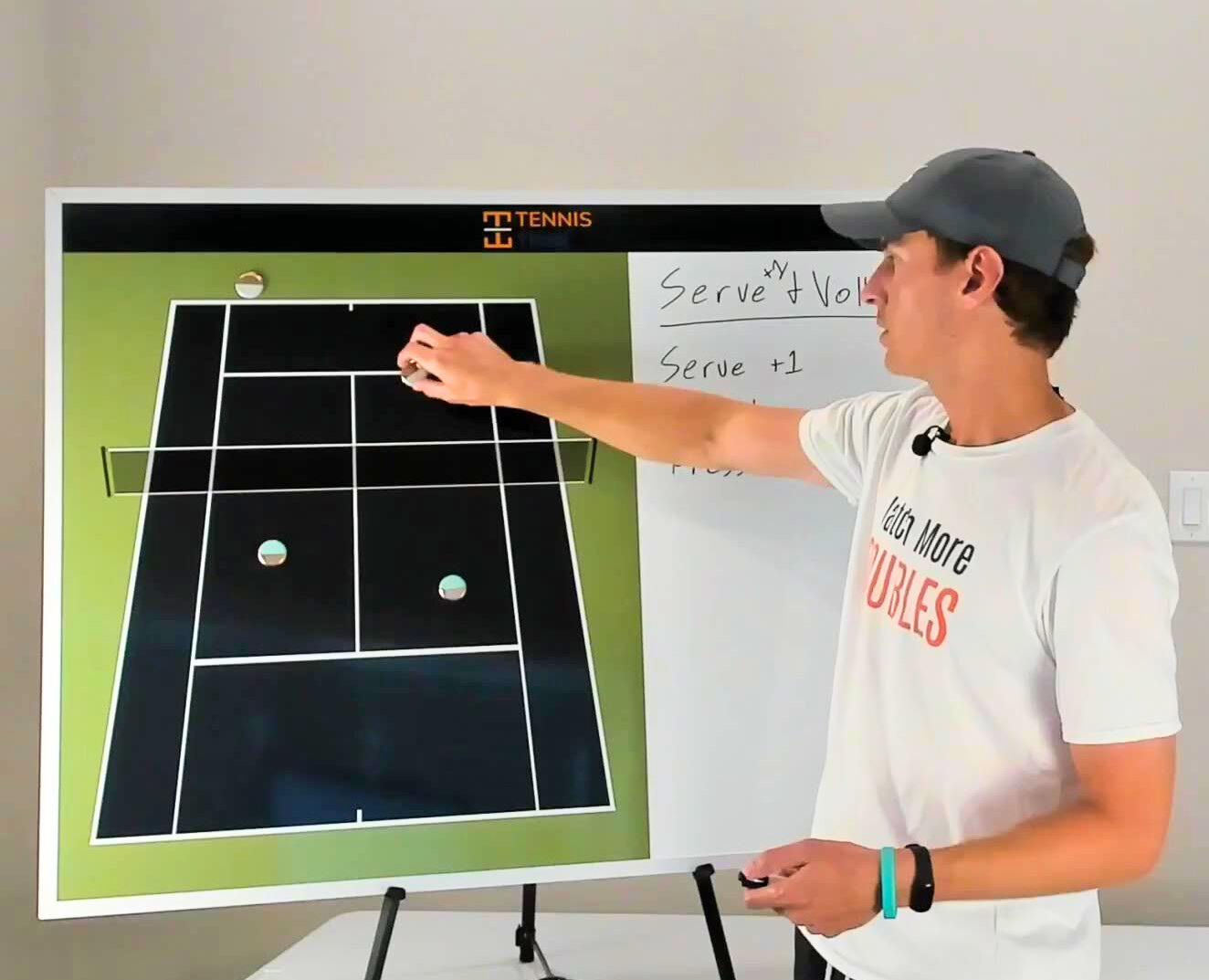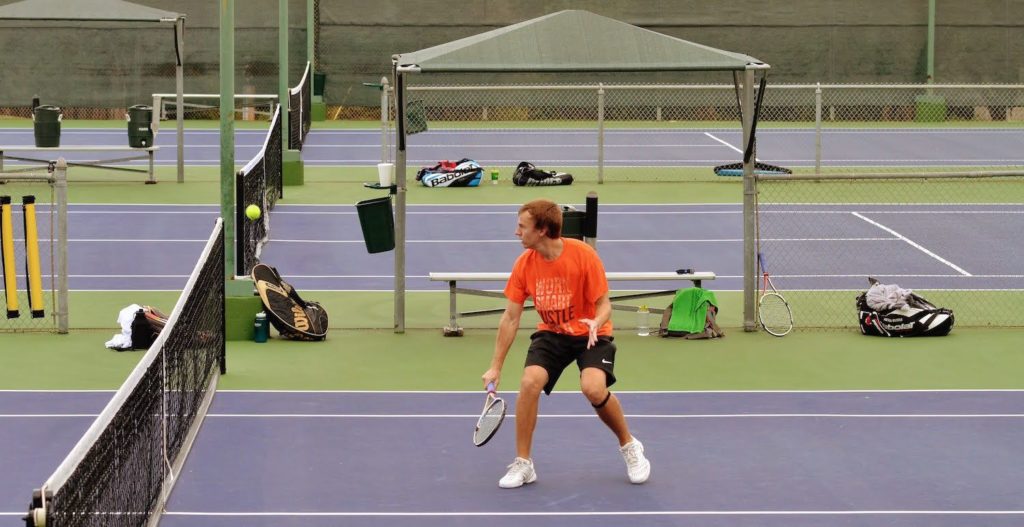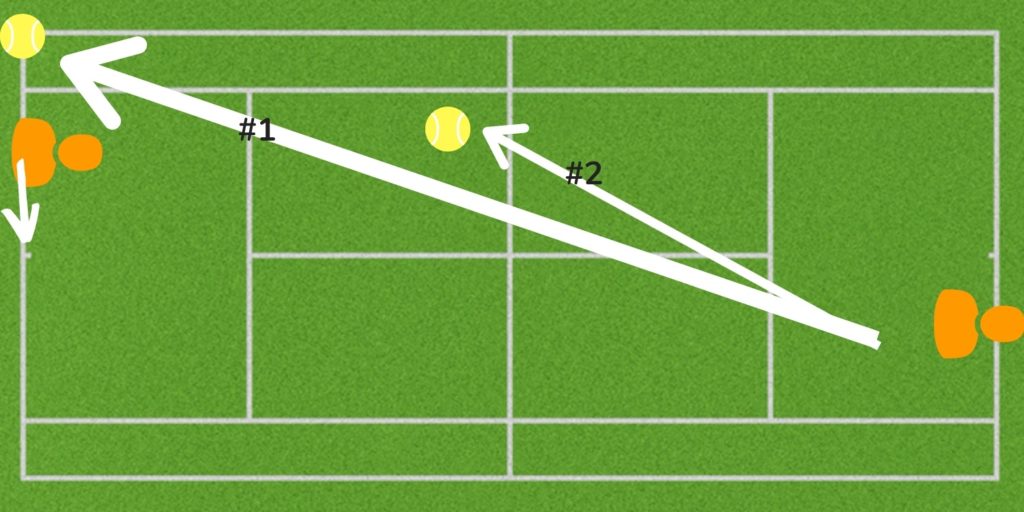This is a guest post written in collaboration with tennis coach and former DI college player, Chase Bartlett. Read more about Chase at the bottom of this page.
Below, you’re going to learn how to hit a drop shot, and the best times to use this tactic in singles.
Most tennis players have a natural tendency to hit the ball hard, and they try to win the point by using power or hitting winners.
This type of one-dimensional tennis fails to take the short slice and drop shot into account. In this article, we will explain how to hurt your opponent with touch and placement, and we will highlight some of the fundamentals of the drop shot in tennis.
What is a Drop Shot in Tennis?
A drop shot is when you hit the ball softly over the net so it lands short in the court. It’s best to hit a drop shot when the opponent is standing somewhere back behind the baseline or out of position.
A good drop shot will land barely over the net. The opponent will not be able to run towards the net to get it before it bounces twice.
In this long rally below, Dimitrov hits a drop shot to try to win the point, then Djokovic counters with another drop shot winner.
Tips for Drop Shot Technique
Technique on the drop shot requires the proper grip and swing path.
Use the Continental Grip for the Drop Shot
When hitting the drop shot, it’s important to use the continental grip, as you would with a slice or hitting a volley. This allows you to hit the ball in front and maximizes control of the placement and spin.
Shorten Your Backswing, Open the Racquet Face, & Swing Under the Ball
If you already have a good backhand or forehand slice, the swing path is very similar.
However, compared to a normal slice, the drop shot has a much shorter backswing. Big backswings generally allow for more power, while short backswings create better timing and feel, helping you to hit the ball softly.
MOST POPULAR COURSE!
25 Winning Doubles Tactics
Guaranteed to help you play smarter & win more matches.
- Over 50 video doubles lessons
- 60+ ATP & WTA points analyzed
- Nearly 3 hours of strategy content

Will Boucek – Doubles Strategy Analyst for ATP & WTA Players and Team USA at the 2024 Olympics
You will open up the face of your tennis racquet a little bit more as well. When making contact, you should come under and slightly across the ball so that it spins backward and a little bit sideways. This will help the ball spin away from your opponent after it lands.
How to Disguise the Drop Shot in Tennis
In order to prevent the opponent from anticipating the drop shot, the best players disguise their drop shots by faking a normal topspin groundstroke. They will switch quickly from their topspin grip to a continental grip for the drop shot
This technique is helpful on both the forehand and backhand. Novak Djokovic, for example, is very good at hiding drop shots on his backhand side and Nick Kyrgios is extremely good at disguising forehand drop shots.
On the first drop shot in this video, you can see Nick start to swing like a normal backhand to disguise the drop shot.
4 Strategy Tips: When to Hit a Drop Shot
Drop shots are an extremely useful tactic on the tennis court when used effectively.
The timing of the drop shot must be perfect in order to hurt your opponent. If you use the drop shot when you’re out of position, then it may result in an error or an easy short ball for your opponent. However, there are several times when it is a good idea to hit a drop shot.

#1: Use a Drop Shot When Your Opponent is Out of Position or Slow
At every level—beginner, intermediate, advanced, or professional—the drop shot is a viable strategy if your opponent is tired, slow, or out of position.
Late in a third-set, for example, the drop shot is an especially useful tool because your opponent isn’t as fresh as they were at the start of the match.
Additionally, if you’ve pulled your opponent off of the court with an angled shot, it’s often effective to play a drop shot back behind them while they are trying to recover. This change of direction will throw the opponent off balance.

#2: When Your Opponent is Comfortable at the Baseline but Not at the Net
Even at the collegiate level, many of the best singles players stay away from the net unless they are forced to come inside of the court. Most players are much better at rallying from the baseline.
In my senior year of college, the year that I became an All-American in singles and doubles, I learned how to draw my opponents out of their comfort zone by hitting short slices or drop shots.
#3: Drop Shots Add Variety When You’ve Been Hitting with Power
Variety is an important tactic for tennis players. If you hurt your opponent with power and push them behind the baseline, then the drop shot is extremely effective.
That’s why extremely explosive players like Nick Kyrgios and Daniil Medvedev hit so many drop shot winners. When your opponent expects a hard shot, deep in the court, the drop shot is a good alternative.
#4: Use the Drop Shot to Approach the Net
Because one of the most common responses to drop shots is to hit another soft or short shot, many of the best players hit the drop shot and move into the net behind it.
By using the drop shot as an approach shot, these players gain positioning in the court and get ready for the next ball. This way, you are also at the net and have narrowed down your opponent’s shot selection by taking away their angles.
They often have to hit up on the ball, so by being at the net, you can hit a volley for a winner.
Free Weekly Doubles Lessons
Join the #1 Doubles Strategy Newsletter and get my Net Play Guide: 3 Doubles Tactics to Force Errors & Get More Easy Volleys for free!
– Will Boucek, ATP & WTA doubles strategy analyst

“I found your site a couple weeks ago and used your guide for net play. It worked well! Playing again this morning so we will see how it goes!”
– Julie, Club Doubles Player
When NOT to Hit the Drop Shot
Never hit drop shots when you are out of position or moving backwards.
Sometimes Federer or Kyrgios hit ridiculous drop shots while completely out of position, but these shots are risky, even for them. These shots might make the “Sportscenter Top 10,” but they won’t consistently win matches.
If you want to hit great drop shots, you need to have your feet balanced and positioned firmly below you.
Additionally, if the drop shot is used too often, it may become predictable. When your opponent starts to anticipate your drop shots, they can get to them quickly and attack the short ball.
How to Defend Against a Drop Shot
Being able to recognize and defend against a drop shot is important for singles players. Here are some helpful tips and tactics to counter the drop shot.
Recognizing Your Opponent’s Drop Shot
When I was just starting to play tennis competitively, my coach taught me that you can visibly tell the difference between slices and drop shots by looking closely at your opponent’s backswing.
If the opponent’s take-back is high, it’s going to be a drop shot. Because you are trying to take pace off of the ball, the swing usually looks like a cup or pendulum.
When your opponent is about to hit a hard slice, however, the swing is much lower and the opponent drives through the ball in a much straighter line.
How to Return a Drop Shot
Once you’ve recognized your opponent’s drop shot, you need to choose what to do with the next ball.
Often, the best players counter a drop shot by playing the ball deep up the line. This allows you to cover the net the best, whereas a deep crosscourt ball would give your opponent more space to hit their shot down-the-line into the open court.
A second strategy for returning a drop shot is to play it back short, as a counter-drop shot. Since you have run forward and are at the net, you are already in position to cover all of your opponent’s best options. They no longer have the opportunity to play another short ball.

Win matches easier & improve faster with better, smarter tactics.
Learn Doubles from a Top 10 ATP & WTA Strategy Analyst
Summary: How to Improve Your Drop Shot
If you don’t use the drop shot in your game, it will be a great strategy to add. The more strategies you can use, the better you will be able to handle different opponents.
The next step is to go practice your drop shots. You can use a tennis ball machine or go play a practice match and work on your drop shot using the tips we discussed above.
- Use a continental grip, take a shorter backswing, swing your racquet through a cupping motion under the ball.
- Disguise the drop shot when you can by faking a groundstroke.
- Use the drop shot selectively and don’t over-do it.
- When you hit the drop shot, experiment with it as an approach shot, too.
- Look for high take-backs to recognize when your opponent is hitting a drop shot.
This was a guest post by Coach Chase Bartlett from Bridgible.
Chase is a tennis coach, as well as the CEO & Founder at Bridgible. He was an NCAA DII college tennis player at St. Edward’s University in Austin, TX. He transferred to division I program, University of Montana, where he played for a year before coaching as a graduate assistant. He was ranked in college as high as #11 nationally for both singles & doubles. Chase also has coaching experience at Austin Tennis Academy, and a UTR rating of 12.


Leave a Reply